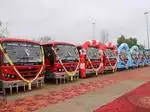Marine Goa Superhighway: Here's Everything You Need To Know
After years of planning and delays, the Marine Goa Superhighway is finally becoming a reality.
With an estimated cost of Rs 26,000 crore, this project aims to ease traffic on the busy Mumbai-Goa highway and enhance transportation along the scenic coast. Here’s everything you need to know about this exciting new highway.
What is the Marine Goa Superhighway?
The Marine Goa Superhighway is a nearly 500-kilometer route designed to run parallel to the existing Goa highway. It aims to ease traffic congestion on the busy Mumbai-Goa highway while providing stunning views of the coastline and Sahyadri mountains.
#MUMBAI After decades of delays, the ambitious ₹26,000-crore Marine Superhighway, planned parallel to the existing Goa highway, is finally moving from the drawing board to the execution stagehttps://t.co/dW63YYsZNi— Maharashtra Inv/Manuf/Tech/Dev Tracking (@abhirammodak) October 17, 2024
Key Features of the Highway
The Marine Goa Superhighway includes seven major bridges, spanning a total of 27 kilometers, which will facilitate transportation and commerce:
Dharamtar Creek Bridge (Karja): A massive 10.2-kilometer steel bridge showcasing modern engineering.
Kundlika Creek Bridge (Revdanda-Salav): This cable-stayed bridge covers 3.8 kilometers, connecting key areas.
Agardanda Creek Bridge (Dighi Agardanda): Another cable-stayed structure, this bridge spans 4.3 kilometers over Agardanda Creek.
Bankot Creek Bridge (Bagmandla Veshwi): This 1.7-kilometer cable-stayed bridge facilitates smooth travel across Bankot Creek.
Kelshi Bay Bridge (Kelshi): A 670-meter long bridge built using a “Box girder” design, providing access over Kelshi Bay.
Jaigad Creek Bridge: At 4.4 kilometers, this cable-stayed bridge enhances connectivity across Jaigad Creek.
Kunkeshwar Bridge: This 1.6-kilometer cable-stayed bridge links key points in Kunkeshwar.
The Marine Goa Superhighway will feature four lanes, similar to California’s famous Pacific Highway. This expressway-like design will connect all the coastal cities of Konkan, making it easier for residents and tourists to travel.

